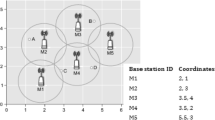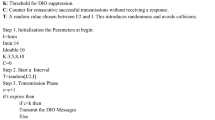Abstract
The beacon order and Superframe order parameter values, as defined by the IEEE 802.15.4 standard specification, constrain the number of data packets that can be transmitted through a network in a given period by inferring the length of the network’s active and inactive periods. Choosing a specific value of either parameter can have significant impact on various quality of service measurements. This study offers a synthesis of the execution result of a large number of networking simulations, carried out using the NS2 tool. The simulations describe networking situations of varying beacon order and Superframe order values, as well as the number of full-function devices and reduced-function devices in randomized topologies. The performance of the networks in each simulation is assessed through measuring standard quality of service measurements, such as the package delivery ratio, throughput, average delay, and consumed energy. The analysis shows that the characteristic curves describing the progression of the quality of service measurements do not vary significantly with respect of the number of devices that comprise a network within the range of simulated values.










Similar content being viewed by others
References
LAN/MAN Standards Committee. (2003). Part 15.4: Wireless medium access control (MAC) and physical layer (PHY) specifications for low-rate wireless personal area networks (LR-WPANs). Washington: IEEE Computer Society.
Movassaghi, S., Abolhasan, M., Lipman, J., Smith, D., & Jamalipour, A. (2014). Wireless body area networks: a survey. IEEE Communications Surveys & Tutorials, 16(3), 1658–1686. https://doi.org/10.1109/SURV.2013.121313.00064.
Cavallari, R., Martelli, F., Rosini, R., Buratti, C., & Verdone, R. (2014). A survey on wireless body area networks: Technologies and design challenges. IEEE Communications Surveys & Tutorials, 16(3), 1635–1657. https://doi.org/10.1109/SURV.2014.012214.00007.
Nourildean, S. W. (2012). A study of zigbee network topologies for wireless sensor network with one coordinator and multiple coordinators. Tikrit Journal of Engineering Sciences, 19(4), 64–80.
Ajgaonkar, P., Wang, L., & Alam, M. (2010). Simulation studies on ZigBee communications for home automation and networking. In AUTOTESTCON (proceedings) (pp. 329–334). IEEE. https://doi.org/10.1109/autest.2010.5613588.
Gungor, V. C., & Hancke, G. P. (2009). Industrial wireless sensor networks: Challenges, design principles, and technical approaches. IEEE Transactions on Industrial Electronics, 56(10), 4258–4265. https://doi.org/10.1109/TIE.2009.2015754.
Perkins, C. E., & Royer, E. M. (1999). Ad hoc on-demand distance vector routing. In Proceedings of the 2nd IEEE workshop on mobile computing systems and applications (pp. 90–100).
Chakeres, I. D., & Belding-Royer, E. M. (2004). AODV routing protocol implementation design. In Proceedings of the 24th international conference on distributed computing systems workshops, 2004 (pp. 698–703).
Kanthe, A. M., Šimunić, D., & Prasad, R. (2012). Comparison of AODV and DSR on-demand routing protocols in mobile ad hoc networks. 1st International Conference on Emerging Technology Trends in Electronics, Communication and Networking (ET2ECN), 1–5. doi:10.1109/ET2ECN.2012.6470118
Al Rasyid, M. U. H., Saputra, F. A., & Ismar, M. R. (2015). Performance of multi-hop networks using beacon and non-beacon scheduling in Wireless Sensor Network (WSN). In 2015 international electronics symposium (IES) (pp. 195–199). IEEE. https://doi.org/10.1109/elecsym.2015.7380840.
Rao, V. P. (2005). The simulative investigation of Zigbee/IEEE 802.15.4. Master Thesis (M.Sc.). Dresden University of Technology. Retrieved September 10, 2018, from http://www.vaddina.com/images/ZIGBEE_zigbee.pdf.
Zheng, J., & Lee, M. J. (2006). A comprehensive performance study of IEEE 802.15.4. Sensor Network Operations, 4, 1–14. https://doi.org/10.1109/ICICS.2005.1689245.
Sheraz, A., Khan, W., Bangash, J., Ullah, S., & Salam, A. (2018). Impact of Beacon Order and Superframe Order on IEEE 802.15. 4 for Nodes Association in WBAN. researchgate.net. Retrieved September 15, 2018, from https://www.researchgate.net/profile/Adil_Sheraz4/publication/322796899_Impact_of_Beacon_Order_and_Superframe_Order_on_IEEE_802154_for_Nodes_Association_in_WBAN/links/5a7065e8aca272e425ec0822/Impact-of-Beacon-Order-and-Superframe-Order-on-IEEE-802154-for-Nodes-Association-in-WBAN.pdf
Sari, R. F. (2012). Analysis of the effect of beacon order and Superframe order value to the performance of multihop wireless networks on IEEE 802.15.4 protocol. In 2012 international conference on advanced computer science and information systems (ICACSIS) (pp. 89–94).
Author information
Authors and Affiliations
Corresponding author
Additional information
Publisher's Note
Springer Nature remains neutral with regard to jurisdictional claims in published maps and institutional affiliations.
Rights and permissions
About this article
Cite this article
Prčić, VL., Kalpić, D., Šimunić, D. et al. A Comprehensive Study of the Impact of Beacon Order and Superframe Order Values on Quality of Service in Multi-hop Wireless Networks on IEEE 802.15.4. Wireless Pers Commun 104, 373–385 (2019). https://doi.org/10.1007/s11277-018-6025-6
Published:
Issue Date:
DOI: https://doi.org/10.1007/s11277-018-6025-6




